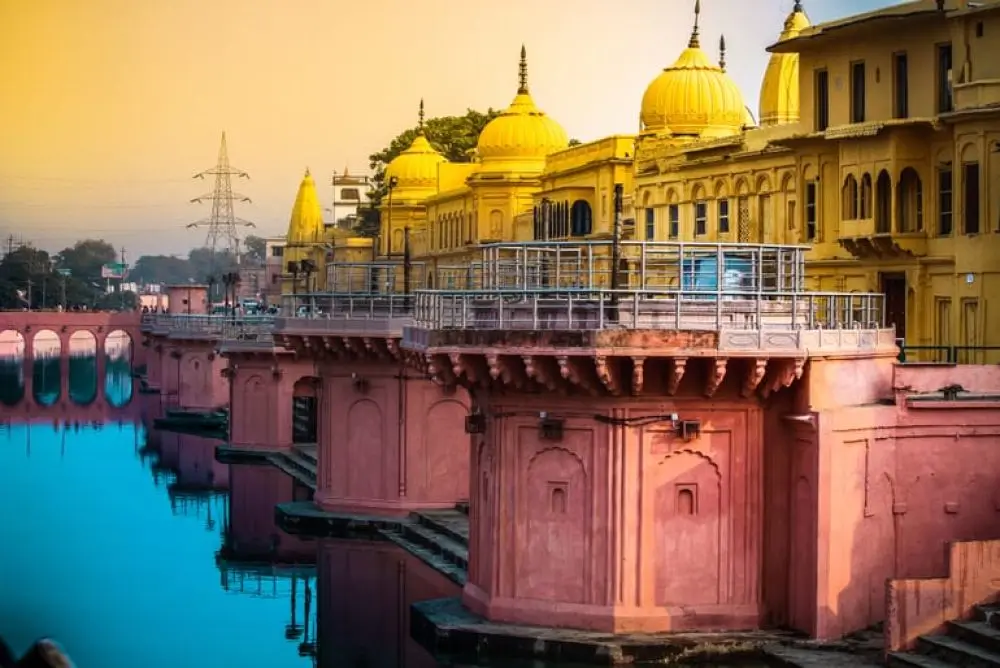The Sacred Pilgrimage of Ayodhya
Ayodhya, the ancient city resting on the banks of the sacred Sarayu River in Uttar Pradesh, is revered as the birthplace of Lord Rama, the seventh incarnation of Lord Vishnu. It holds a central place in the hearts of millions of Hindus and is considered one of the seven Mokshadayini cities (cities that grant liberation).
According to the epic Ramayana, Ayodhya was the glorious capital of the Ikshvaku dynasty and the birthplace of Lord Rama. Ruled by King Dasharatha, this divine city became the backdrop to the values of dharma (righteousness), sacrifice, devotion, and truth that Lord Rama embodied throughout his life.

Places to Visit During Your Yatra

Shri Ram Janmabhoomi
The most sacred site in Ayodhya, believed to be the exact spot where Lord Rama was born. The newly constructed Shri Ram Mandir, grand in architecture and spiritual energy, draws pilgrims from all over the world to witness the divine glory of Maryada Purushottam Ram.

Hanuman Garhi
A temple dedicated to Lord Hanuman, perched atop a hill, where devotees seek blessings before proceeding to the Ram Janmabhoomi. It is believed that Hanuman still guards the city of Rama.

Kanak Bhawan
A beautiful temple said to have been gifted to Sita by Queen Kaikeyi after her marriage to Rama. The richly adorned idols of Rama and Sita in this temple fill devotees with joy and devotion.

Ram Ki Paidi (Sarayu Ghat)
A series of ghats on the banks of the Sarayu River where pilgrims take holy dips. It’s also the site of mesmerizing evening aartis, especially during festivals like Diwali and Ram Navami.

Treta Ke Thakur
A sacred temple built where Saint Tulsidas composed the Ramcharitmanas, with its walls adorned by verses from the epic.
Ayodhya Dham Yatra Guide
Best Time to Visit
The ideal time to visit Ayodhya is from October to March, when the weather is cool and comfortable, making it perfect for sightseeing, temple visits, and spiritual exploration.
Summers (April to June) can be extremely hot with temperatures rising up to 45°C, which can make outdoor activities and temple visits uncomfortable.
Monsoon season (July to September) brings moderate to heavy rainfall, adding to the region’s natural beauty but sometimes causing travel delays and making temple visits less convenient due to slippery paths and waterlogging.
Special Festival Times:
- Ram Navami (March-April): Celebrates Lord Ram's birthday
- Deepotsav (October-November): Grand celebration during Diwali
- Makar Sankranti (January): Devotees gather at the ghats for holy dips in the Saryu River
- Shravan Month (July–August) : Special prayers and rituals, especially at Shiva temples like Nageshwarnath Temple.
How to Reach
By Air
Bamrauli airport at Allahabad is the nearest airport, 106 km. away from Chitrakoot. Next is Khajuraho Airport which is 167 km away from Chitrakoot. Both the airports have daily flight services to Delhi.
By Train
From Chitrakoot to Hajrat Nizamuddin (N. Delhi) via Banda.
From Chitrakoot to Allahabad, Mughal Sarai, Hawraha via Manikpur.
From Chitrakoot to Kurla (Mumbai) via Jhansi.
From Chitrakoot to Lucknow via Banda.
From Chitrakoot to Varanasi via Manikpur.
By Road
From Chitrakoot to Mirzapur via Allahabad.
From Chitrakoot to Rajapur.
From Chitrakoot to Panna via Attra & Naraini.
From Chitrakoot to Banda, Kanpur & Lucknow.
From Chitrakoot to Sagar via Mahoba.
Accommodation Options
Chitrakoot offers a range of accommodation options catering to different budgets and preferences:
- Dharamshalas: Run by various trusts and religious organizations, offering simple and affordable accommodation.
- Government Guest Houses: Comfortable stay options managed by the government tourism department.
- Private Hotels: Several budget to mid-range hotels are available in and around Chitrakoot.
- Ashrams: Some ashrams offer accommodation for spiritual seekers with simple facilities.
It's advisable to book your accommodation in advance, especially during peak seasons and festivals.
Essential Tips for Pilgrims
- Wear comfortable clothing and footwear as you'll be walking a lot.
- Carry a water bottle, sunscreen, and a hat, especially during summer.
- Remove footwear before entering temples as a mark of respect.
- Photography may be restricted in some temple areas; always ask for permission.
- Maintain silence and decorum in temple premises.
- Dress modestly when visiting temples.
- Consider hiring a local guide for a better understanding of the historical and religious significance.
- Plan for at least 2-3 days to cover all the important religious sites comfortably.